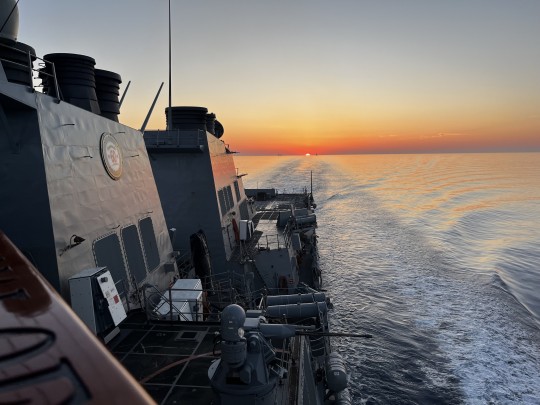#Arleigh Burke-class
Explore tagged Tumblr posts
Text
youtube
#youtube#militarytraining#usmilitary#Watch as the USS John Basilone (DDG 122)#a powerful Arleigh Burke-class guided-missile destroyer#makes its way through the Upper Bay#navigating the waters near New Jersey and New York on November 4#2024.
2 notes
·
View notes
Text

USS John Paul Jones (DDG-53) in drydock at Vigor Shipyard in Seattle, Washington. Photographed on January 26, 2023.
"Vigor, a Titan company, has been awarded a $131 million U.S. Navy contract to complete a docking selected restricted availability (DSRA) on USS John Paul Jones (DDG 53) at Harbor Island in Seattle. The ship arrived at Harbor Island on November 4, becoming the fourth U.S. Navy vessel currently undergoing maintenance at the Seattle shipyard."
Vigor Shipyard website: link
Posted on Reddit: link
#USS John Paul Jones (DDG-53)#USS John Paul Jones#Arleigh Burke Class#Guided Missile Destroyer#Destroyer#warship#ship#drydock#dry dock#Seattle#Washington#United States Navy#us navy#navy#usn#u.s. navy#my post
61 notes
·
View notes
Video
youtube
4D Model - USS Arleigh Burke - 1/1000 - Mini Kit
#youtube#4D Model#USS Arleigh Burke#Arleigh Burke Class#Arleigh Burke Destroyer#Aegis Destroyer#Model Ship#Model Building#Mini Kit#Original Content
0 notes
Text
As China’s 'encirclement' of Taiwan continues, US warship sails through South China Sea
New Post has been published on https://www.timesofocean.com/as-chinas-encirclement-of-taiwan-continues-us-warship-sails-through-south-china-sea/
As China’s 'encirclement' of Taiwan continues, US warship sails through South China Sea
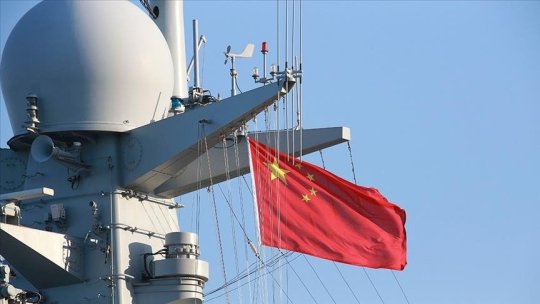
Istanbul (The Times Groupe) – Beijing conducted joint flights of jets and naval frigates on Monday after a US warship sailed through the disputed South China Sea.
People’s Liberation Army (PLA) said it “organized naval and air forces to track and monitor” the US Navy destroyer USS Milius that “illegally trespassed into waters near China’s Meiji Reef in Nansha Islands in the South China Sea on Monday.”
Earlier on Monday, the 7th Fleet of the US military in Asia-Pacific deployed its Arleigh Burke-class guided-missile destroyer USS Milius (DDG 69) in the South China Sea.
On April 10, the Arleigh Burke-class guided-missile destroyer USS Milius (DDG 69) asserted navigational rights and freedoms in the South China Sea near the Spratly Islands, consistent with international law.
Read more: https://t.co/BcOAXsufuO pic.twitter.com/PNyja70Vbv
— 7th Fleet (@US7thFleet) April 10, 2023
The fleet said it “asserted navigational rights and freedoms in the South China Sea near the Spratly Islands, consistent with international law.”
“ After completing the operation, USS Milius exited the excessive claim area and continued operations in the South China Sea.
Within 12 nautical miles of Mischief Reef, the United States conducted normal operations. Mischief Reef, which is submerged at high tide in its naturally formed state, is not entitled to a territorial sea under customary international law, according to the statement.
During the US warship’s voyage, China continued its three-day “military sword” exercises around Taiwan.
According to the Chinese daily Global Times, the PLA Navy Shandong aircraft carrier group was in waters east of Taiwan island where Chinese sorties, including those of J-15 carrier-borne fighter jets equipped with live missiles, took off and landed.
Taiwan’s Defense Ministry said its air defense units “remain on high alert for contingencies, steadfastly maintaining their posts 24/7, showing that we can and we will defend our skies.”
Taiwan detected 70 PLA aircraft and 11 PLA naval vessels around the island nation earlier today, 35 of which crossed the Taiwan Strait and entered Taiwan’s southwest and southeast air defense identification zones (ADIZ).
“And we will never give up our beliefs,” Taiwan’s Defense Ministry said on Twitter.
Neither the median line nor the ADIZ are recognized in Beijing.
In response to Taiwan’s President Tsai Ing-wen’s 10-day trip to Central America last week, US House Speaker Kevin McCarthy hosted Tsai Ing-wen for a meeting in California.
#Arleigh Burke-class guided-missile destroyer USS Milius (DDG 69)#asia pacific#Beijing#California#Chinese daily Global Times#disputed South China Sea#international law#Istanbul#jets#military exercises#military sword#Mischief Reef#naval frigates#People's Liberation Army (PLA)#south china sea#Taiwan#Taiwan's President Tsai Ing-wen#Taiwan’s Defense Ministry#United States#US House Speaker Kevin McCarthy#US Navy destroyer USS Milius#us warship#US warship's voyage#USS Milius#Politics
0 notes
Text

Thinking about it. I may have seen a pair of these side by side when I visited a friend in Seattle back in 2019.


Ticonderoga class cruiser vs Arleigh Burke destroyer.
The Burkes eventually became a cost-effective alternative to the expensive Ticonderogas, and are now slated to replace them, following the failure of the Zumwalt class.
74 notes
·
View notes
Text

The USS Michael Murphy (DDG-112) is an Arleigh Burke-class guided-missile destroyer in the U.S. Navy.
168 notes
·
View notes
Text

USS The Sullivans DDG-68 Arleigh Burke class Destroyer US Navy.
241 notes
·
View notes
Text

AC-130 Gunship’s Laser Weapon Cancelled, 105mm Howitzer May Be Removed
The AC-130J was set to get the first operational airborne laser weapon, but that plan is over as the gunship changes to ensure its relevance.
Joseph TrevithickPUBLISHED Mar 19, 2024 1:56 PM EDT
The US Air Force no longer plans to flight test a laser directed energy weapon on an AC-130J Ghostrider gunship.
USAF
The U.S. Air Force has scrapped plans to flight test an AC-130J Ghostrider gunship armed with a laser directed energy weapon after years of delays. The Airborne High Energy Laser program for the AC-130J had for a time looked set to become the U.S. military's first operational aerial laser directed weapon. This all also comes amid a review of the AC-130J's current and future planned capabilities, which could see the gunships lose their 105mm howitzers, as part of a broader shift away from counter-insurgency operations to planning for a high-end fight.
Air Force Special Operations Command (AFSOC) confirmed that there are no longer plans to test the prototype Airborne High Energy Laser (AHEL) system on an AC-130J and provided other details about the current state of the program to The War Zone earlier today.
"After accomplishing significant end-to-end high power operation in an open-air ground test, the AHEL solid state laser system experienced technical challenges," an AFSOC spokesperson said in a statement. "These challenges delayed integration onto [the] designated AC-130J Block 20 aircraft past the available integration and flight test window."

One past US Air Force rendering of an AC-130 with a laser directed energy weapon. USAF
The original hope was flight testing of an AC-130J with the AHEL system would take place sometime in the 2021 Fiscal Year, but this schedule was repeatedly pushed back. In November 2023, AFSOC told The War Zone that a laser-armed Ghostrider was set to take to the skies in January of this year, something that clearly did not occur.
Lockheed Martin received the initial contract in 2019 to supply the AHEL's laser source for the system and lead the effort to integrate the system onto an AC-130J. The complete AHEL system also includes a beam director and other components.

A now-dated US Special Operations Command briefing slide discussing the AHEL program and the components of the weapon system itself. SOCOM
"As a result, the program was re-focused on ground testing to improve operations and reliability to posture for a successful hand off for use by other agencies," the statement added.
This is all further confirmed by the Pentagon's 2025 Fiscal Year budget request, which was rolled out last week, and does not ask for any new funding for AHEL. Official budget documents say this is because the program is expected to close out in the 2024 Fiscal Year.
What "other agencies" might now be in line to benefit from the AHEL program's work and the exact status of the 60-kilowatt class laser directed energy weapon system developed under the program are unclear. AFSOC directed further questions to U.S. Special Operations Command, which The War Zone has now reached out to for more information.
The U.S. Navy's Naval Surface Warfare Center Dahlgren Division (NSWC Dahlgren) had already been deeply involved in the AHEL program. The Navy has been very active in the development and fielding of various types of shipboard directed energy weapons, including another 60-kilowatt class laser directed energy weapon called the High-Energy Laser with Integrated Optical Dazzler and Surveillance, or HELIOS. Lockheed Martin is also the prime contractor for that system.

The US Navy's Arleigh Burke class destroyer USS Preble pierside in San Diego in July 2022. The ship's HELIOS directed energy weapon system can be seen on a platform immediately in front of the main superstructure. USN
The U.S. Army and U.S. Marine Corps have also been working to develop and field different types of air and ground-based directed energy weapons.
The Air Force has been working on at least one other aerial laser directed energy weapon in recent years, under the Air Force Research Laboratory's (AFRL) Self-protect High Energy Laser Demonstrator (SHiELD) program. The SHiELD effort was centered around a podded system for tactical jets ostensibly intended to help defend against incoming missiles, though it would have the ability to engage other target sets. In the past, the stated goal was to begin flight testing of the SHiELD pod in 2025, but its current status is unclear.

A rendering of a US Air Force F-16C Viper fighter with a podded laser directed energy weapon. Lockheed Martin
The Air Force is pursuing other directed energy weapon programs, including for base defense use on the ground. Additional work is understood to be going on in the classified realm, including efforts tied to the larger Next-Generation Air Dominance (NGAD) initiative.
For the Air Force's current fleet of 30 AC-130Js, the end of the AHEL program comes amid larger questions about the future of Ghostrider's armament package and other current and future capabilities. There are growing signs that the Ghostriders are set to lose their 105mm howitzers as part of this reassessment of the aircraft's capabilities.
"Initiate engineering analysis and development to remove the aft weapon system (105mm Gun), refit the aft section, and optimize crew workload in support of the United States Special Operations Command (USSOCOM) crew reduction initiatives," is the plan for the AC-130Js in the 2024 Fiscal Year, according to the Pentagon's latest budget request. The War Zone has reached out to AFSOC for further clarification.
The Air Force originally planned not to include a 105mm howitzer in the armament package for the AC-130J, which was originally focused more on the employment of precision-guided missiles and bombs than guns at all. The service subsequently changed course and had more recently been in the process of integrating improved howitzers onto the Ghostriders. That work came to a halt last year after the start of the capability review. As of last November, only 17 of the 30 AC-130Js had gotten this upgrade.
youtube
AFSOC has been taking this new look at the Ghostrider's current and future planned capabilities in large part due to discussions about how AC-130Js might contribute to future high-end conflicts, especially one in the Pacific against China. AC-130Js, which are today primarily tasked with providing very close support to special operations forces on the ground, currently operate almost exclusively in permissive and semi-permissive environments and at night.
AHEL has been presented in the past as being ideally suited to supporting lower-intensity counter-insurgency-type missions.
"Without the slightest bang, whoosh, thump, explosion, or even aircraft engine hum, four key targets [an electrical transformer, the engine of a pick-up truck, communication equipment, and a parked drone,] are permanently disabled," now-retired Lt. Gen. Brad Webb, then head of AFSOC, said in a 2017 interview with National Defense magazine, describing a notional mission for a laser-armed AC-130. "The enemy has no communications, no escape vehicle, no electrical power, and no retaliatory intelligence, surveillance, and reconnaissance capability. Minutes later, the team emerges from the compound, terrorist mastermind in hand. A successful raid."
In line with all this, the Air Force is also looking to add a new active electronically-scanned array (AESA) radar to these gunships, "allowing the platform to detect, target, identify, and engage across a spectrum of threats at longer ranges and react with greater precision," according to Pentagon budget documents. You can read more about the benefits of adding an AESA to the AC-130J here.
Other specialized C-130 variants belonging to AFSOC have been heavily involved in the testing of a palletized weapon system called Rapid Dragon. Rapid Dragon offers a way to readily transform existing cargo aircraft into launch platforms for AGM-158 Joint Air-to-Surface Standoff Missile (JASSM) cruise missiles and other stand-off munitions. SOCOM has previously expressed interest in the past in integrating precision-guided munitions with longer reach onto the AC-130, in part to help keep those aircraft away from increasingly capable enemy air defenses. A return to a focus on precision-guided munition employment when it comes to the Ghostriders could be important for ensuring their continued operational relevance.
youtube
Altogether, the exact mix of capabilities found on the AC-130Js looks set to significantly evolve in the near term. However, a laser directed energy weapon is no longer on the horizon for the Ghostriders.
Howard Altman contributed to this story.
Contact the author: [email protected]
@warzonewire via X
25 notes
·
View notes
Text



Two of the U.S. Navy’s Arleigh Burke-Class Guided-Missile Destroyers off the Coast of Israel, USS Cole (DDG-67), and USS Buckeley (DDG-84), launched over a Dozen Interceptors against tonight’s Iranian Ballistic Missiles
8 notes
·
View notes
Text

US Navy Arleigh Burke-class DDG launching Tomahawk cruise missiles at Houthi targets in Yemen earlier tonight, 11 Jan 2024
26 notes
·
View notes
Text

PACIFIC OCEAN (Nov. 23, 2023) The Arleigh Burke-class guided-missile destroyer USS William P. Lawrence (DDG 110) maintains position during rigid-hull inflatable boat operations in the Pacific Ocean, Nov. 22, 2023. (U.S. Navy photo by Mass Communication Specialist 1st Class Jesse Monford)
21 notes
·
View notes
Text
WHY ARE WE RETIRING any of our front line modern combat ships. Arleigh Burke-class destroyers are among the most modern and capable ships in our Navy
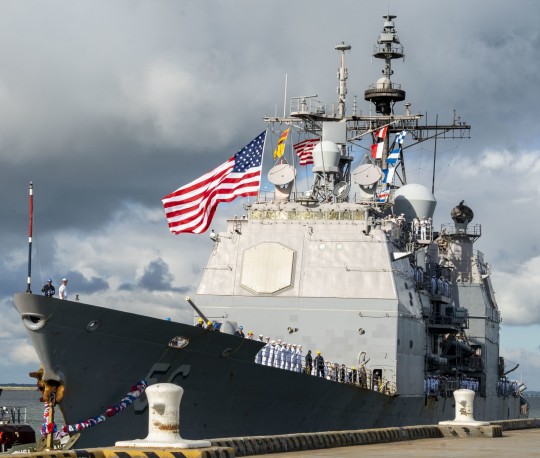
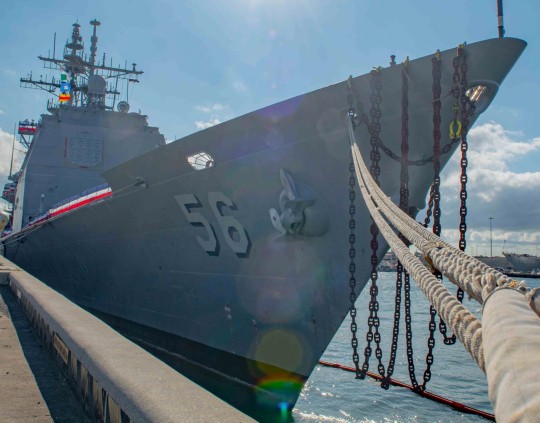
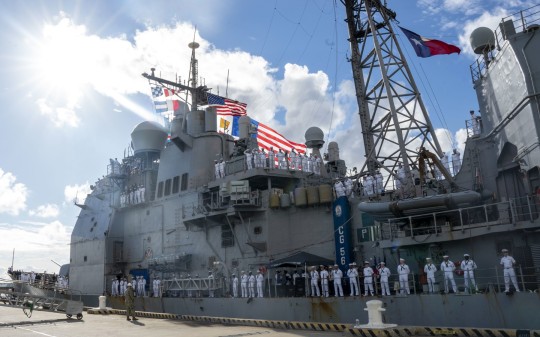

"Vice Adm. Jim Kilby, commander, Task Force 80 and deputy commander, U.S. Fleet Forces, gives the keynote address during the decommissioning ceremony of USS San Jacinto (CG-56). San Jacinto was decommissioned after more than 35 years of service. Modern U.S. Navy guilded-missile cruisers perform multiple mission including Air Warfare (AW), Undersea Warfare (USW), Naval Surface Fire Support (NSFS) and Surface Warfare (SUW) surface combatants capable of supporting carrier battle groups, amphibious forces or operating independently and as flagships of surface action groups."
Date: September 25, 2023
US Navy photo by Mass Communication Specialist 2nd Class Matthew Nass.
230915-N-TY639-1258
source
29 notes
·
View notes
Text

Port side view showing the damage sustained by the Arleigh Burke class guided missile destroyer USS Cole (DDG 67) on October 12, 2000, after an Al Qadea terrorist bomb exploded during a refueling operation in the port of Aden, Yemen.
3 notes
·
View notes
Text
#4DModel #arleighburkeclassdestroyer #minikit #modelship #modelbuilding #burkeclassdestroyer #arleighburkeclass
instagram
#4D Model#arleigh burke class destroyer#mini kit#model ship#model building#burke class destroyer#arleigh burke class#uss arleigh burke#original content#Instagram
0 notes
Text

Vice Admiral Samuel Lee Gravely Jr. (June 4, 1922 – October 22, 2004) was a Navy officer who pioneered the way with many firsts for African Americans in the military. Some of his most notable achievements included being the first African American Navy Vice Admiral, the first African American to command a Navy warship, the first African American to command a warship during combat, the first African American to command a Navy Fleet, and the first African American to obtain Flag Rank in the military. His decorations include the Bronze Star, Legion of Merit, Navy Commendation Medal, and Meritorious Service Medal.
He was born in Richmond, Virginia. He attended Virginia Union University for three years, where he was a member of Alpha Phi Alpha. He enlisted in the Naval Reserve in 1942 where he trained as a fireman apprentice.
He was commissioned an Ensign following his successful completion of a rigorous Midshipman education. He attended UCLA, Pre-Midshipman school, and Midshipman school at Columbia University. He became the first African American commissioned as a Naval Reserve Officer.
He was stationed at Camp Robert Smalls, where he served as the Assistant Battalion Commander for recruits. In April of 1946, he was released from active duty, recommencing his studies at Virginia Union University, where he earned a BA in History.
He was recalled to active duty and was assigned as a recruiter. He was stationed aboard the Battleship Iowa and the Cruiser Toledo where he served as a communications officer during the Korean War.
He was transferred from the Naval Reserve to the regular Navy. He was promoted to Commander of the USS Falgout (DER-324). He became Commander of the USS Jouett (DLG-29). He was elevated to the appointment of Rear Admiral. He assumed control over the entire Third Fleet.
He served as Director of the Defense Communications Agency. He served 38 years in the Navy. The Arleigh Burke-class missile destroyer DDG-107 has been named in his honor. #africanhistory365 #africanexcellence #alphaphialpha
5 notes
·
View notes
